2011 年 3 月翻译资格英语高级口译笔试真题
SECTION 1: LISTENING TEST
(30 minutes)
Part A: Spot Dictation
Directions: In this part of the test, you will hear a passage and read the same passage
with blanks in it. Fill in each of the blanks with the world or words you have heard
on the tape. Write your answer in the corresponding space in your ANSWER BOOKLET.
Remember you will hear the passage ONLY ONCE.
Play is very important for humans from birth to death. Play is not meant to be just
for children. It is a form of ___________ (1) that can tap into your creativity,
and can allow you the chance to find your inner child and the inner child of others.
I have collected the ___________ (2) of play here.
Play can stimulate you ___________ (3). It can go against all the rules, and change
the same ___________ (4). Walt Disney was devoted to play, and his willingness to
___________ (5) changed the world of entertainment. The next time you are stuck in
a ___________ (6) way of life, pull out a box of color pencils, modeling clay, glue
and scissors, and ___________ (7) and break free. You will be amazed at the way your
thinking ___________ (8).
Playing can bring greater joy into your life. What do you think the world would be
like-if ___________ (9) each day in play? I bet just asking you this question has
___________ (10). Play creates laughter, joy, entertainment, ___________ (11).
Starting today, try to get 30 minutes each day to engage in some form of play, and
___________ (12) rise!
Play is known ___________ (13). Studies show that, as humans, play is part of our
nature. We have the need to play because it is instinctive and ___________ (14).
With regular play, our problem-solving and ___________ (15) will be in much better
shape to handle this complex world, and we are much more likely to choose ___________
(16) as they arise. It creates laughter and freedom that can instantly reduce stress
and __________ (17) to our daily living.
Play can ___________ (18), curiosity, and creativity. Research shows that play is
both a ‘hands-on’ and ‘minds-on’ learning process. It produces a deeper,
___________ (19) of the world and its possibilities. We begin giving meaning to life
through story making, and playing out ___________ (20).
Part B: Listening Comprehension
Directions: In this part of the test there will be some short talks and conversations.
After each one, you will be asked some questions. The talks, conversations and
questions will be spoken ONLY ONCE. Now listen carefully and choose the right answer
to each question you have heard and write the letter of the answer you have chosen
in the corresponding space in your ANSWER BOOKLET.
Questions 1 to 5 are based on the following conversation.
1. (A) in Cherry Blossoms Village ninety of the residents are over 85 years old.
(B) In the United States, there are twice as many centenarians as there were ten
�
years ago.
(C) All the people studied by these scientists from Georgia live in institutions
for the elderly.
(D) Almost all the residents in Cherry Blossoms Village have unusual hobbies.
2. (A) Whether the centenarians can live independently in small apartments.
(B) Whether it is feasible to establish a village for the “oldest old” people.
(C) What percentage of the population are centenarians in the state of Georgia.
(D) What the real secrets are to becoming an active and healthy 100-year-old.
3. (A) Diet, optimism, activity or mobility, and genetics.
(B) Optimism, commitment to interesting things, activity or mobility, and
adaptability to loss.
(C) The strength to adapt to loss, diet, exercise, and genetics.
(D) Diet, exercise, commitment to something they were interested in, and genetics.
4. (A) The centenarians had a high calorie and fat intake.
(B) The centenarians basically eat something different.
(C) The centenarians eat a low-fat and low-calorie, unprocessed food diet.
(D) The centenarians eat spicy food, drink whiskey, and have sweet pork every day.
5. (A) Work hard.
(B) Stay busy.
(C) Stick to a balanced diet.
(D) Always find something to laugh about.
Questions 6 to 10 are based on the following news.
6. (A) Global temperatures rose by 3 degrees in the 20th century.
(B) Global warming may spread disease that could kill a lot of people in Africa.
(C) Developed countries no longer depend on fossil fuels for transport and power.
(D) The impact of the global warming will be radically reduced by 2050.
7. (A) Taking bribes.
(B) Creating a leadership vacuum at the country’s top car maker.
(C) Misusing company funds for personal spending.
(D) Offering cash for political favors.
8. (A) The nation has raised alert status to the highest level and thousands of people
have moved to safety.
(B) The eruption of Mount Merapi has been the worst in Indonesia over the past two
decades.
(C) All residents in the region ten kilometers from the base of the mountain have
evacuated.
(D) The eruption process was a sudden burst and has caused extensive damage and heavy
casualty.
9. (A) 6 to 7.
(B) 8 to 10.
(C) 11 to 16.
(D) 17 to 25.
10. (A) Curbing high-level corruption.
(B) Fighting organized crime.
�
(C) Investigating convictions of criminals.
(D) Surveying the threats to national security.
Questions 11 to 15 are based on the following interview.
11. (A) A wine taster.
(B) A master water taster.
(C) The host of the show.
(D) The engineer who works on the water treatment plant.
12. (A) Berkeley Springs.
(B) Santa Barbara.
(C) Atlantic City.
(D) Sacramento.
13. (A) Being saucy and piquant.
(B) Tasting sweet.
(C) A certain amount of minerals.
(D) An absence of taste.
14. (A) Looking—smelling—tasting.
(B) Tasting—smelling—looking.
(C) Smelling—looking—tasting.
(D) Tasting—looking—smelling.
15. (A) Bathing.
(B) Boiling pasta in.
(C) Swimming.
(D) Making tea.
Questions 16 to 20 are based on the following talk.
16. (A) Enhance reading and math skills.
(B) Increase the students’ appreciation of nature.
(C) Improve math, but not reading skills.
(D) Develop reading, but not math skills.
17. (A) To help the students appreciate the arts.
(B) To make the students’ education more well-rounded.
(C) To investigate the impact of arts training.
(D) To enhance the students’ math skills.
18. (A) Once weekly.
(B) Twice weekly.
(C) Once a month.
(D) Twice a month.
19. (A) Six months.
(B) Seven months.
(C) Eight months.
(D) Nine months.
20. (A) The children’s attitude.
(B) The children’s test scores.
(C) Both the children’s attitude and test scores.
(D) Both the teachers’ and the children’s attitude.
�
SECTION 2: READING TEST
(30 minutes)
Directions: In this section you will read several passages. Each one is followed
by several questions about it. You are to choose ONE best answer, (A), (B), (C) or
(D), to each question. Answer all the questions following each passage on the basis
of what is stated or implied in that passage and write the letter of the answer you
have chosen in the corresponding space in your ANSWER BOOKLET.
Questions 1—5
Anyone who doubts that children are born with a healthy amount of ambition need spend
only a few minutes with a baby eagerly learning to walk or a headstrong toddler
starting to talk. No matter how many times the little ones stumble in their initial
efforts, most keep on trying, determined to master their amazing new skill. It is
only several years later, around the start of middle or junior high school, many
psychologists and teachers agree, that a good number of kids seem to lose their
natural drive to succeed and end up joining the ranks of underachievers. For the
parents of such kids, whose own ambition is often inextricably tied to their
children’s success, it can be a bewildering, painful experience. So it’s no wonder
some parents find themselves hoping that, just maybe, ambition can be taught like
any other subject at school.
It’s not quite that simple.“Kids can be given the opportunities to become passionate
about a subject or activity, but they can’t be forced,” says Jacquelynne Eccles,
a psychology professor at the University of Michigan, who led a landmark, 25-year
study examining what motivated first-and seventh-grades in three school districts.
Even so, a growing number of educators and psychologists do believe it is possible
to unearth ambition in students who don’t seem to have much. They say that by
instilling confidence, encouraging some risk taking, being accepting of failure and
expanding the areas in which children may be successful, both parents and teachers
can reignite that innate desire to achieve.
Figuring out why the fire went out is the first step. Assuming that a kid doesn’
t suffer from an emotional or learning disability, or isn’t involved in some family
crisis at home, many educators attribute a sudden lack of motivation to a fear of
failure or peer pressure that conveys the message that doing well academically
somehow isn’t cool. “Kids get so caught up in the moment-to-moment issue of will
they look smart or dumb, and it blocks them from thinking about the long term,”
says Carol Dweck, a psychology professor at Stanford. “You have to teach them that
they are in charge of their intellectual growth.” Over the past couple of years,
Dweck has helped run an experimental workshop with New York City public school
seventh-graders to do just that. Dubbed Brainology, the unorthodox approach uses
basic neuroscience to teach kids how the brain works and how it can continue to
develop throughout life. “The message is that everything is within the kids’
control, that their intelligence is malleable,” says Lisa Blackwell, a research
scientist at Columbia University who has worked with Dweck to develop and run the
program, which has helped increase the students’ interest in school and turned
around their declining math grades. More than any teacher or workshop, Blackwell
�
says, “parents can play a critical role in conveying this message to their children
by praising their effort, strategy and progress rather than emphasizing their
‘smartness’ or praising high performance alone. Most of all, parents should let
their kids know that mistakes are a part of learning.”
Some experts say our education system, with its strong emphasis on testing and rigid
separation of students into different levels of ability, also bears blame for the
disappearance of drive in some kids. “These programs shut down the motivation of
all kids who aren’t considered gifted and talented. They destroy their
confidence,” says Jeff Howard, a social psychologist and president of the Efficacy
Institute, a Boston-area organization that works with teachers and parents in school
districts around the country to help improve children’s academic performance.
Howard and other educators say it’s important to expose kids to a world beyond
homework and tests, through volunteer work, sports, hobbies and other
extracurricular activities. “The crux of the issue is that many students experience
education as irrelevant to their life goals and ambitions,” says Michael Nakkual,
a Harvard education professor who runs a Boston-area mentoring program called
Project IF (Inventing the Future), which works to get low-income underachievers in
touch with their aspirations. The key to getting kids to aim higher at school is
to disabuse them of the notion that classwork is irrelevant, to show them how doing
well at school can actually help them fulfill their dreams beyond it. Like any
ambitious toddler, they need to understand that you have to learn to walk before
you can run.
1. Which of the following best expresses the main idea of the first paragraph?
(A) Children are born with a kind of healthy ambition.
(B) How a baby learns to walk and talk.
(C) Ambition can be taught like other subjects at school.
(D) Some teenage children lose their drive to succeed.
2. According to some educators and psychologists, all of the following would be
helpful to cultivate students’ ambition to succeed EXCEPT ________.
(A) stimulating them to build up self-confidence
(B) cultivating the attitude of risk taking
(C) enlarging the areas for children to succeed
(D) making them understand their family crisis
3. What is the message that peer pressure conveys to children?
(A) A sudden lack of motivation is attributed to the student’s failure.
(B) Book knowledge is not as important as practical experience.
(C) Looking smart is more important for young people at school.
(D) To achieve academic excellence should not be treated as the top priority.
4. The word “malleable” in the clause “that their intelligence is malleable,”
(para.3) most probably means capable of being ________.
(A) altered and developed
(B) blocked and impaired
(C) sharpened and advanced
(D) replaced and transplanted
�
Questions 6—10
5. The expression “to disabuse them of the notion” (para.4) can be paraphrased
as ________.
(A) to free them of the idea
(B) to help them understand the idea
(C) to imbue them with the notion
(D) to inform them of the concept
Civil-liberties advocates reeling from the recent revelations on surveillance had
something else to worry about last week: the privacy of the billions of search queries
made on sites like Google, AOL, Yahoo and Microsoft. As part of a long-running court
case, the government has asked those companies to turn over information on its
users’ search behavior. All but Google have handed over data, and now the Department
of Justice has moved to compel the search giant to turn over the goods.
What makes this case different is that the intended use of the information is not
related to national security, but the government’s continuing attempt to police
Internet pornography. In 1998, Congress passed the Child Online Protection Act
(COPA), but courts have blocked its implementation due to First Amendment concerns.
In its appeal, the DOJ wants to prove how easy it is to inadvertently stumble upon
pore. In order to conduct a controlled experiment—to be performed by a UC Berkeley
professor of statistics—the DOJ wants to use a large sample of actual search terms
from the different search engines. It would then use those terms to do its own
searches, employing the different kinds of filters each search engine offers, in
an attempt to quantify how often “material that is harmful to minors” might appear.
Google contends that since it is not a party to the case, the government has not
right to demand its proprietary information to perform its test. “We intend to
resist their motion vigorously,” said Google attorney Nicole Wong.
DOJ spokesperson Charles Miller says that the government is requesting only the
actual search terms, and not anything that would link the queries to those who made
them. (The DOJ is also demanding a list of a million Web sites that Google indexes
to determine the degree to which objectionable sites are searched.) Originally, the
government asked for a treasure trove of all searches made in June and July 2005;
the request has been scaled back to one week’s worth of search queries.
One oddity about the DOJ’s strategy is that the experiment could conceivably sink
its own case. If the built-in filters that each search engine provides are effective
in blocking porn sites, the government will have wound up proving what the opposition
has said all along—you don’t need to suppress speech to protect minors on the Net.
“We think that our filtering technology does a good job protecting minors from
inadvertently seeing adult content,” says Ramez Naam, group program manager of MSN
Search.
Though the government intends to use these data specifically for its COPA-related
test, it’s possible that the information could lead to further investigations and,
perhaps, subpoenas to find out who was doing the searching. What if certain search
terms indicated that people were contemplating terrorist actions or other criminal
activities? Says the DOJ’s Miller, “I’m assuming that if something raised alarms,
we would hand it over to the proper authorities.” Privacy advocates fear that if
�
the government request is upheld, it will open the door to further government
examination of search behavior. One solution would be for Google to stop storing
the information, but the company hopes to eventually use the personal information
of consenting customers to improve search performance. “Search is a window into
people’s personalities,” says Kurt Opsahl, an Electronic Frontier Foundation
attorney. “They should be able to take advantage of the Internet without worrying
about Big Brother looking over their shoulders.”
6. When the American government asked Google, AOL, Yahoo and Microsoft to turn over
information on its users’ search behavior, the major intention is _________.
(A) to protect national security
(B) to help protect personal freedom
(C) to monitor Internet pornography
(D) to implement the Child Online Protection Act
7. Google refused to turn over “its proprietary information”(para.2) required by
DOJ as it believes that ________.
(A) it is not involved in the court case
(B) users’ privacy is most important
(C) the government has violated the First Amendment
(D) search terms is the company’s business secret
8. The phrase “scaled back to” in the sentence “the request has been scaled back
to one week’s worth of search queries” (para.3) can be replaced by _________.
(A) maximized to
(B) minimized to
(C) returned to
(D) reduced to
9. In the sentence “One oddity about the DOJ’s strategy is that the experiment
could conceivably sink its own case.”(para.4), the expression “sink its own case”
most probably means that _________.
(A) counterattack the opposition
(B) lead to blocking of porn sites
(C) provide evidence to disprove the case
(D) give full ground to support the case
10. When Kurt Opsahl says that “They should be able to take advantage of the Internet
without worrying about Big Brother looking over their shoulders.” (para.5), the
expression “Big Brother” is used to refer to _________.
(A) a friend or relative showing much concern
(B) a colleague who is much more experienced
(C) a dominating and all-powerful ruling power
(D) a benevolent and democratic organizationQuestions 11—15
On New Year’s Day, 50,000 inmates in Kenyan jails went without lunch. This was not
some mass hunger strike to highlight poor living conditions. It was an extraordinary
humanitarian gesture: the money that would have been spent on their lunches went
to the charity Food Aid to help feed an estimated 3.5 million Kenyans who, because
of a severe drought, are threatened with starvation. The drought is big news in Africa,
�
affecting huge areas of east Africa and the Horn. If you are reading this in the
west, however, you may not be aware of it—the media is not interested in old stories.
Even if you do know about the drought, you may not be aware that it is devastating
one group of people disproportionately: the pastoralists. There are 20 million
nomadic or semi-nomadic herders in this region, and they are fast becoming some of
the poorest people in the continent. Their plight encapsulates Africa’s perennial
problem with drought and famine.
How so? It comes down to the reluctance of governments, aid agencies and foreign
lenders to support the herders’ traditional way of life. Instead they have tended
to try to turn them into commercial ranchers or agriculturalists, even though it
has been demonstrated time and again that pastoralists are well adapted to their
harsh environments, and that moving livestock according to the seasons or climatic
changes makes their methods far more viable than agriculture in sub-Saharan
drylands.
Furthermore, African pastoralist systems are often more productive, in terms of
protein and cash per hectare, than Australian, American and other African ranches
in similar climatic conditions. They make a substantial contribution to their
countries’ national economies. In Kenya, for example, the turnover of the
pastoralist sector is worth $800 million per year. In countries such as Burkina Faso,
Eritrea and Ethiopia, hides from pastoralists’ herds make up over 10 per cent of
export earnings. Despite this productivity, pastoralists still starve and their
animals perish when drought hits. One reason is that only a trickle of the profits
goes to the herders themselves; the lion’s share is pocketed by traders. This is
partly because the herders only sell much of their stock during times of drought
and famine, when they need the cash to buy food, and the terms of trade in this
situation never work in their favour. Another reason is the lack of investment in
herding areas.
Funding bodies such as the World Bank and-USAID tried to address some of the problems
in the 1960s, investing millions of dollars in commercial beef and dairy production.
It didn’t work. Firstly, no one bothered to consult the pastoralists about what
they wanted. Secondly, rearing livestock took precedence over human progress. The
policies and strategies of international development agencies more or less mirrored
the thinking of their colonial predecessors. They were based on two false assumptions:
that pastoralism is primitive and inefficient, which led to numerous failed schemes
aimed at converting herders to modern ranching models; and that Africa’s drylands
can support commercial ranching. They cannot. Most of Africa’s herders live in areas
with unpredictable weather systems that are totally unsuited to commercial ranching.
What the pastoralists need is support for their traditional lifestyle. Over the past
few years, funders and policy-makers have been starting to get the message. One
example is intervention by governments to ensure that pastoralists get fair prices
for their cattle when they sell them in times of drought, so that they can afford
to buy fodder for their remaining livestock and cereals to keep themselves and their
families alive (the problem in African famines is not so much a lack of food as a
lack of money to buy it). Another example is a drought early-warning system run by
�
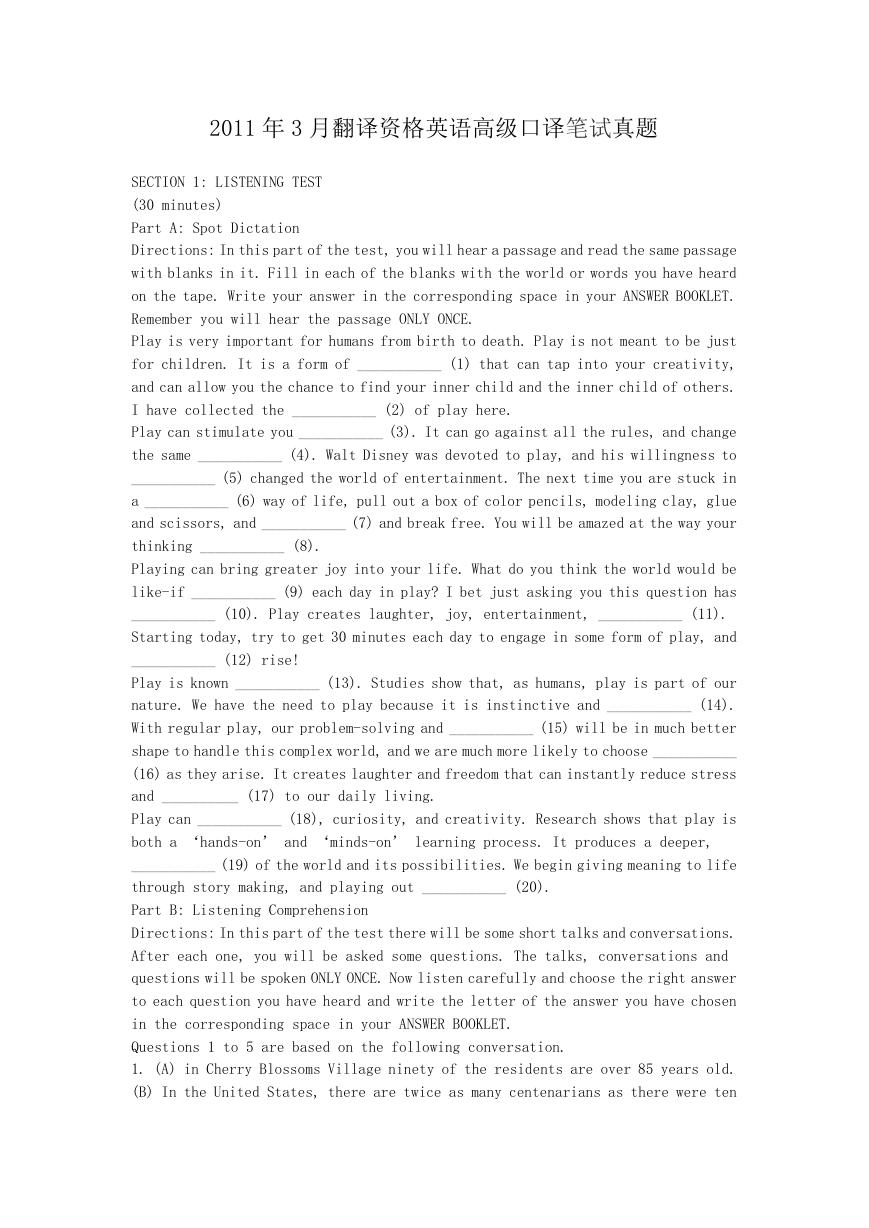
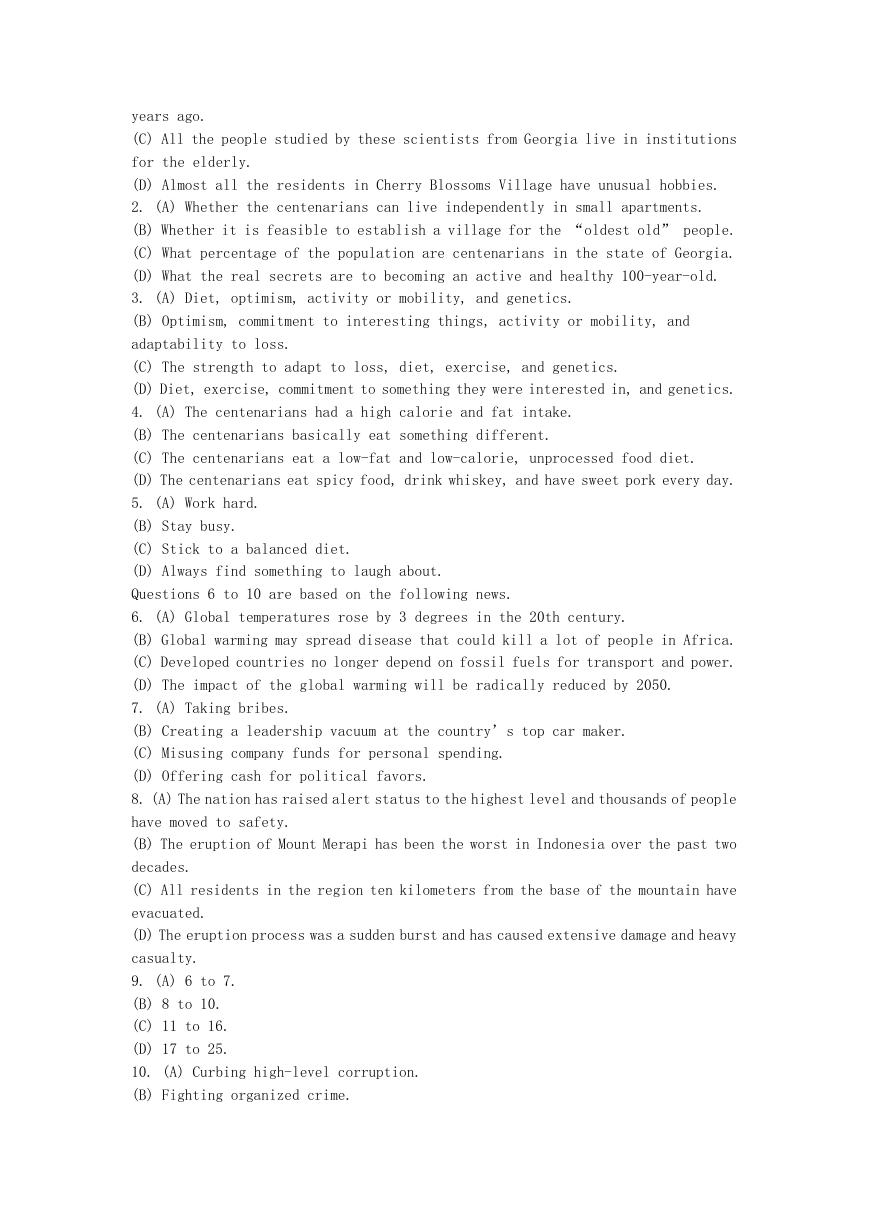

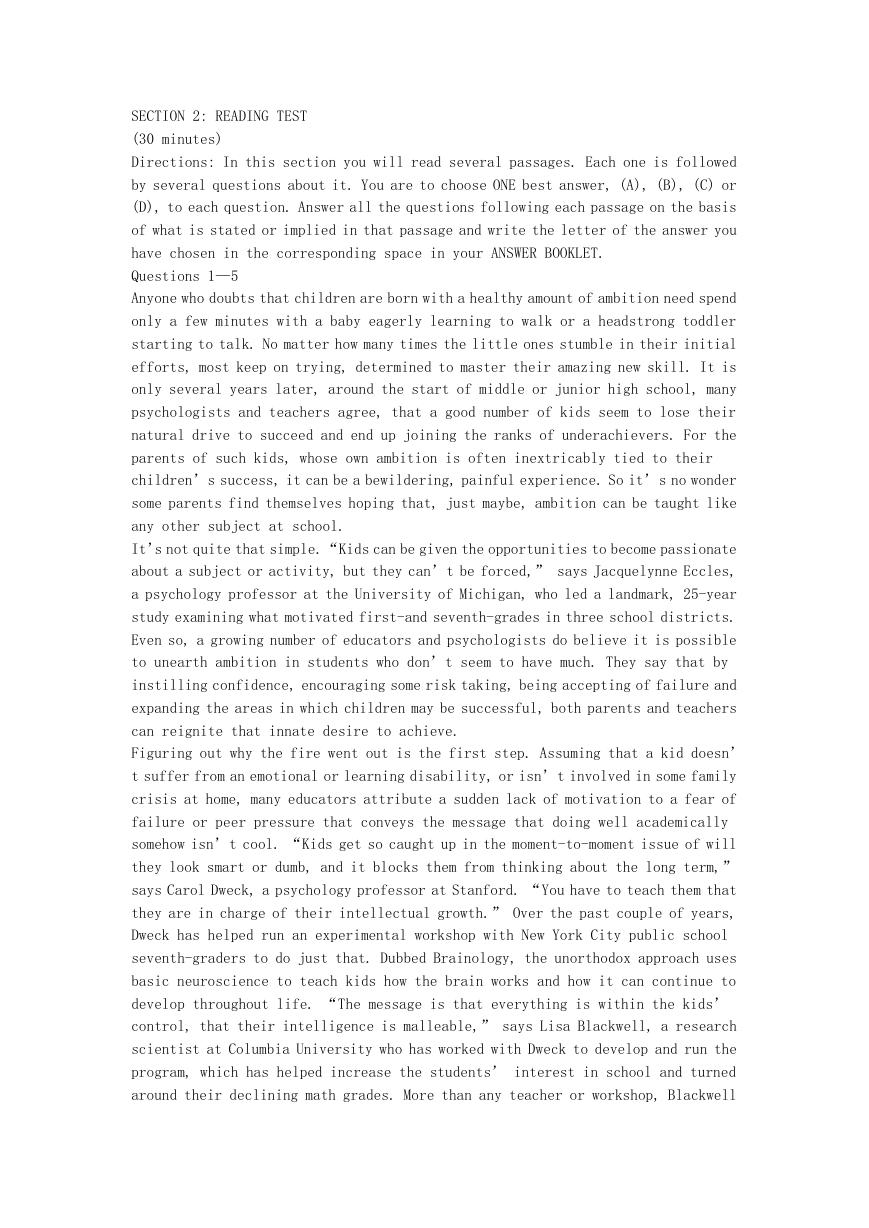
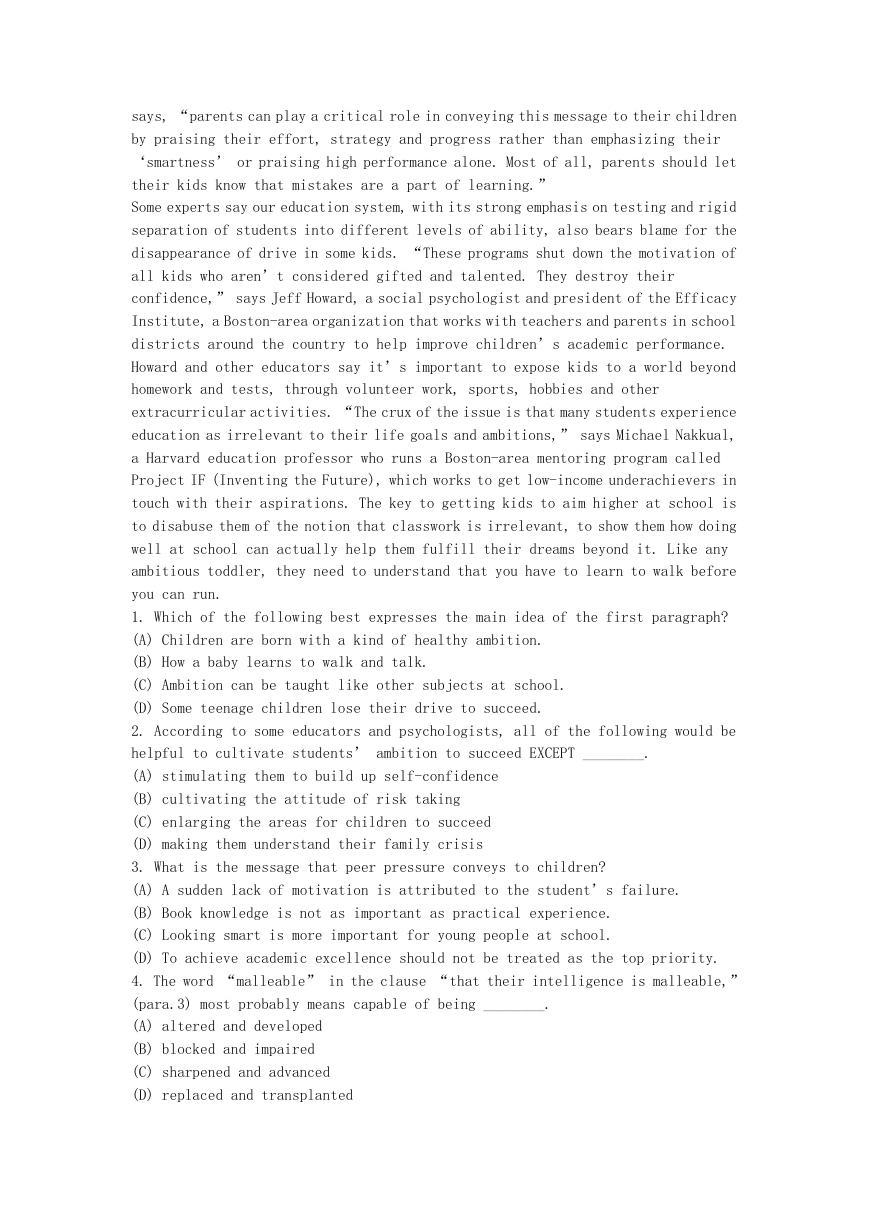
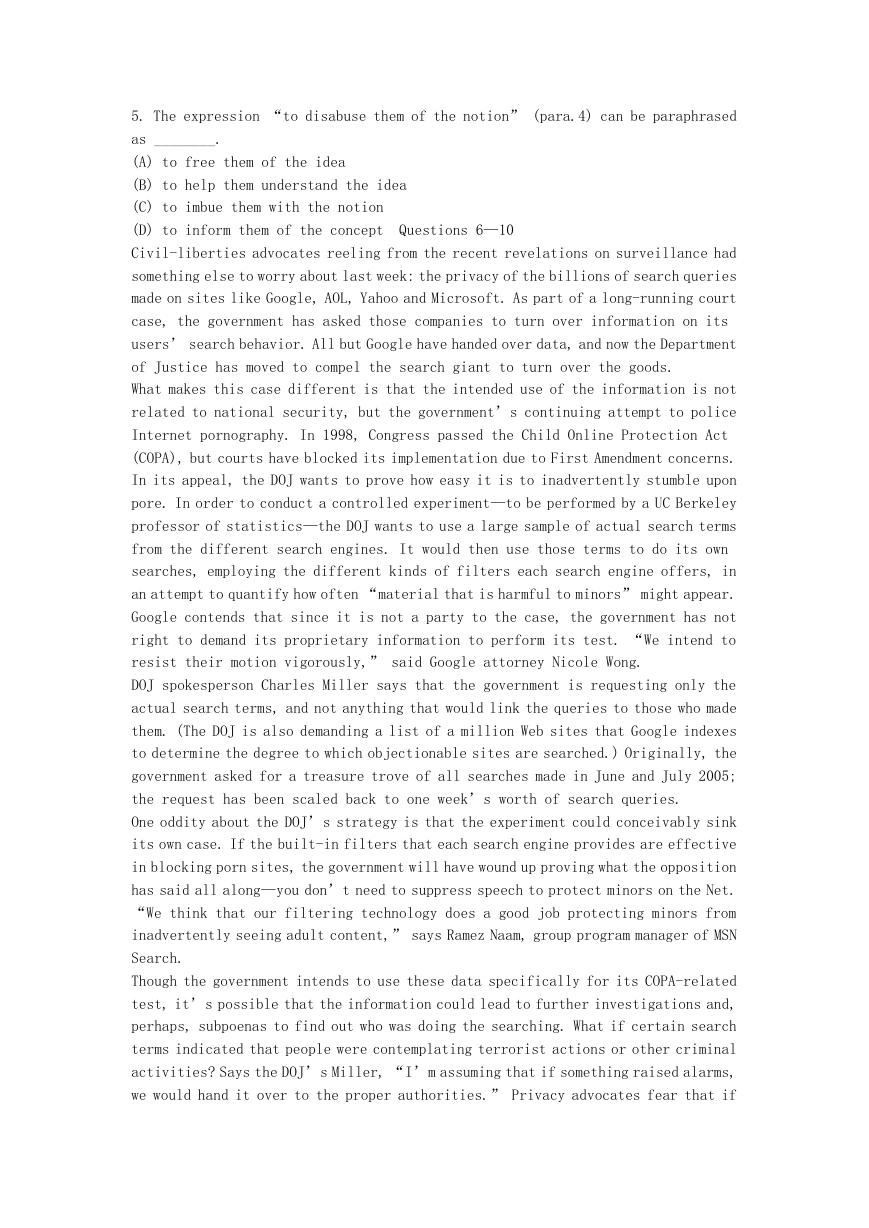
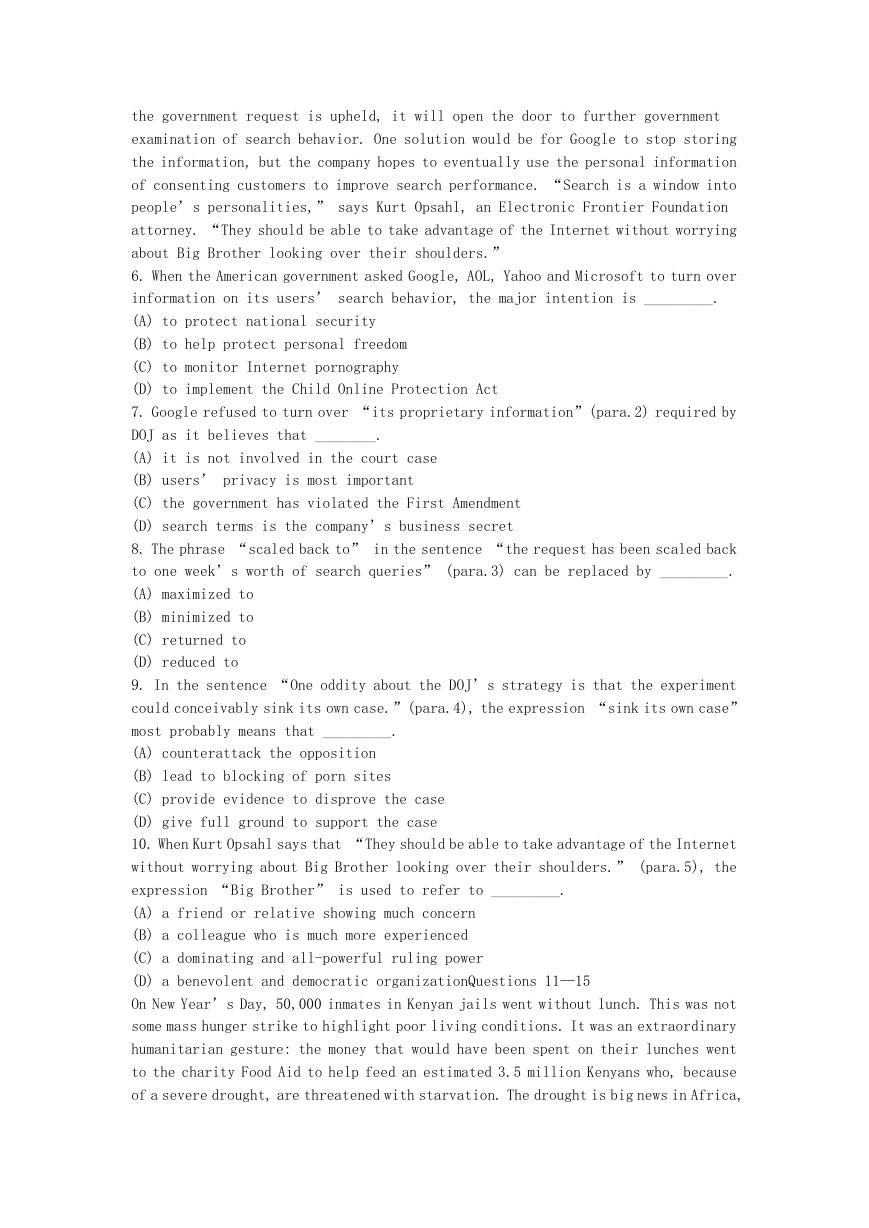
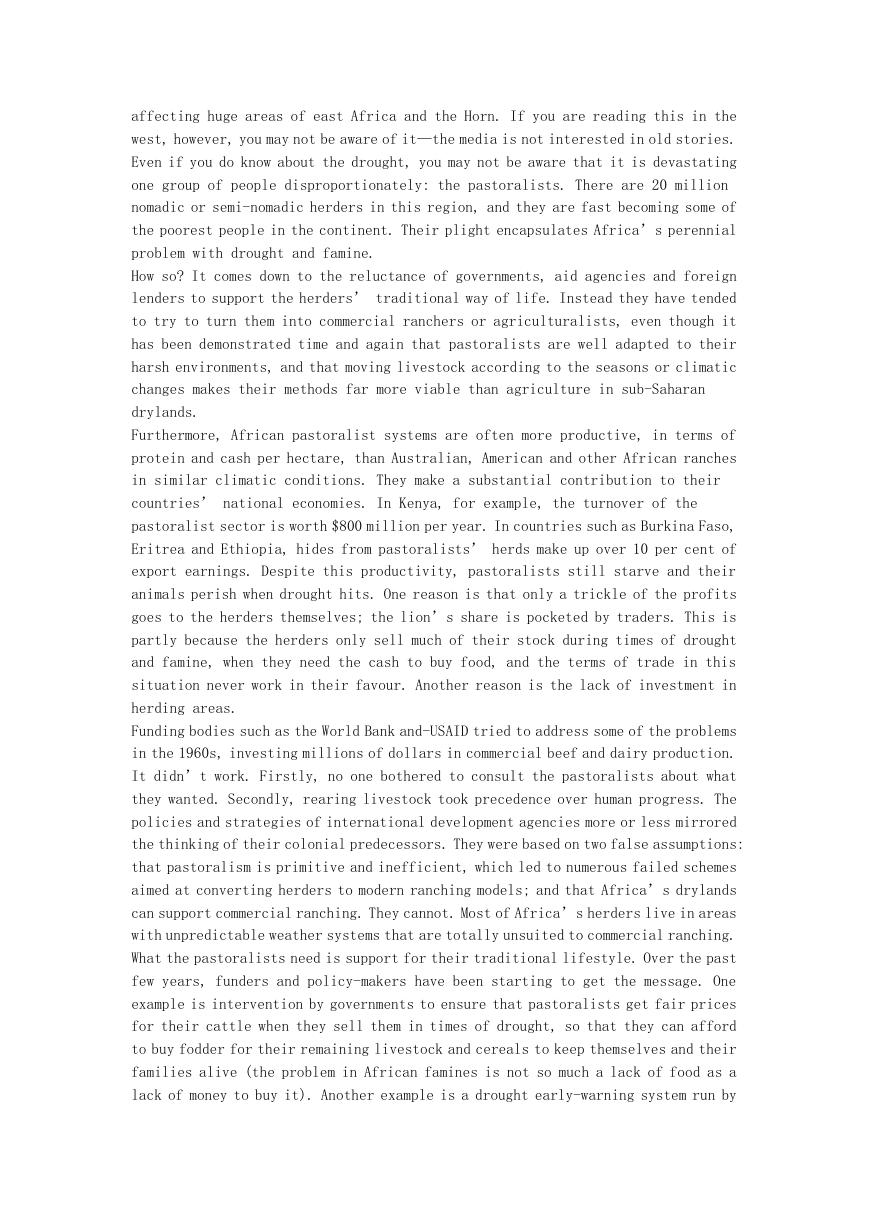








 2023年江西萍乡中考道德与法治真题及答案.doc
2023年江西萍乡中考道德与法治真题及答案.doc 2012年重庆南川中考生物真题及答案.doc
2012年重庆南川中考生物真题及答案.doc 2013年江西师范大学地理学综合及文艺理论基础考研真题.doc
2013年江西师范大学地理学综合及文艺理论基础考研真题.doc 2020年四川甘孜小升初语文真题及答案I卷.doc
2020年四川甘孜小升初语文真题及答案I卷.doc 2020年注册岩土工程师专业基础考试真题及答案.doc
2020年注册岩土工程师专业基础考试真题及答案.doc 2023-2024学年福建省厦门市九年级上学期数学月考试题及答案.doc
2023-2024学年福建省厦门市九年级上学期数学月考试题及答案.doc 2021-2022学年辽宁省沈阳市大东区九年级上学期语文期末试题及答案.doc
2021-2022学年辽宁省沈阳市大东区九年级上学期语文期末试题及答案.doc 2022-2023学年北京东城区初三第一学期物理期末试卷及答案.doc
2022-2023学年北京东城区初三第一学期物理期末试卷及答案.doc 2018上半年江西教师资格初中地理学科知识与教学能力真题及答案.doc
2018上半年江西教师资格初中地理学科知识与教学能力真题及答案.doc 2012年河北国家公务员申论考试真题及答案-省级.doc
2012年河北国家公务员申论考试真题及答案-省级.doc 2020-2021学年江苏省扬州市江都区邵樊片九年级上学期数学第一次质量检测试题及答案.doc
2020-2021学年江苏省扬州市江都区邵樊片九年级上学期数学第一次质量检测试题及答案.doc 2022下半年黑龙江教师资格证中学综合素质真题及答案.doc
2022下半年黑龙江教师资格证中学综合素质真题及答案.doc